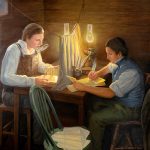Associated Locations:
- Wylam, Northumberland, England – Birthplace
Associated Dates:
- 9 June 1781 – Born
George Stephenson is one of the eminent spirits who appeared to President Wilford Woodruff in the St. George Temple on August 21, 1877. This interesting story is detailed in the Eminent Spirits Appear to Wilford Woodruff wiki.
On 4 June 1881, in a supplement to the London News, a former acquaintance of George Stephenson wrote:
All this great and good in the English character found expression in the career of George Stephenson. He will go down to posterity a type of the physical and moral virtues of his race.
An athlete, he was a lover of birds [and a] giant in strength…. The greatest practical engineer the world has seen, he maintained his supremacy with unaffected modesty. With opportunities to amass a colossal fortune, he put gold aside as dross compared with honour.
The article then quoted Stephenson’s response to a request for his name and address. The request had compared him to royalty. Stephenson said: “I have dined with princes, and peers, and commoners—with persons of all classes, from the highest to the humbles…. I have seen mankind in all its phases, and the conclusion I have arrived at is—that if we were all stripped there’s not much difference between us.”
“Do as I have done—persevere!”
-George Stephenson
Life Sketch from The Other Eminent Men of Wilford Woodruff
Copyright © Taken from the book: The Other Eminent Men of Wilford Woodruff. Special thanks to Vicki Jo Anderson. Please do not copy.
English Father of the Railway 1781-1848
Early Life

George Stephenson was the second son of Mary Carr and Robert Stephenson. His father was a fireman of a coal pit engine, near Newcastle. Stephenson was born on 9 June 1781. As with other great Englishmen, Stephenson had a mother of remarkable character who had a great concern for the welfare of her son. Those who knew Mrs. Stephenson referred to her as a “canny body” which was a way of saying that she was clever, good, and very reliable. The family existed in rather poor circumstances and there was no money to send George to school. One historian remarked that had Stephenson had an education, he would have made his mark on the world, but would probably not have been the father of the railway. It was his very surroundings, the environment of the mining community that helped his mind to concentrate on what his hands and mind could do.
At the age of eight he had to help the family by going to work herding cows fora nearby neighbor. This job was a great stimulus to his love of the outdoors and particularly to his lifelong attachment to birds. His responsibilities included not only herding but also opening and closing the gate on the main road for wagons. He acutely observed everything that passed by. Another young boy, named Thirwall, helped young Stephenson herd the animals. The two boys loved to play on the banks of nearby streams, building tiny windmills at each opportunity. These interests and activities led them to design model engines out of clay, using hemlock stems as steam-pipes. They made small wagons out of cork and ran them by means of a miniature winding-machine. From his job of tending cows, he moved to hoeing. Finally, he got a job he greatly desired driving the “gin” horse, adjacent to the coal pit.
At fourteen he obtained the position of assistant fireman under his father at the coal pit. It was here that his engineering mind began to blossom, yet he still preserved his great love for birds and knew every local nest in the area. His great ambition during this time was to become the engineer man on the old steam engine that pumped water out of the mine. To become familiar with the machine, he spent hours studying it and taking it apart to help repair it. His mind thrived on such exercises, and they prepared him to realize his potential. Then at the age of seventeen, he was promoted over his father to the office of engineman.
Amazing Perseverance
Although, Stephenson excelled in many areas, by the time he was 18 years old, he still could not read. He often sat listening as others read him the latest news. He finally concluded that if he was to advance, particularly in his skill as a mechanic, he would have to read. He signed up for a class by a local minister to learn the basic skills of reading and writing. He learned with great rapidity and even learned his “sums” while working. Mathematics seemed a natural part of his genius.
Stephenson had great plans of the future. He did not waste time at the local pub with the other miners. He wanted his future family to have a better lot in life than he himself had experienced. He had three basic goals: to become a skilled workman, to win the confidence of his employers, and to have the respect of his neighbors. In order to add to the meager wage he earned from the mine, Stephenson mended shoes in the evening. He repaired clocks and watches as well. He fixed anything he could “put a hand to.” He was known in the village for holding the record for throwing the hammer the greatest distance.
Marriage and Fanny’s Death
Among the shoes he mended were those of a beautiful young woman named Fanny Henderson. Fanny was a servant of one of the more well to do families. It didn’t take much for these two exceptional people to fall in love. But Stephenson’s wage was so small that they could not marry. They waited a year. By then Stephenson had purchased a small cottage and they were married at Newburg Church. After the ceremony the young couple traveled together on a single horse to pay their respects to Stephenson’s parents. They then rode over fifteen miles to their new cottage.
On 16 October 1803, a son Robert was born. Soon after this the family moved to Killingsworth, where Stephenson worked in the West Moor Coal mine. They had been married just twelve months when Fanny died. Stephenson was devastated. She had been the bright star in his life. She believed in his hopes and dreams, even his impossible dreams. He lost himself in his work superintending a Boulton and Watt spinning gin.
Working on Engineering

He was called to Scotland to apply his practical knowledge to a coal put engine that kept drawing sand. After studying the situation fora time, Stephenson ordered a twelve-foot box built and placed in the well. He set the pump inside, and it worked without drawing sand. When he returned home with a goodly sum of money, he found that his father has been blinded in a mine accident. Stephenson paid off his father’s debts and took his parents under his care. About this time he was drafted into the Continental Army. Working at extra jobs he was able to pay a “substitute” to serve for him, allowing him to stay home and take care of his little son and parents.
In 1808, with two other men, Stephenson took a small contract for managing all the engines at West Moor Pit. Saving all he could, Stephenson was able to send young Robert to school. He worked hard and made little. His luck soon changed. A new engine has been put in at Killingsworth, and for some reason no one could keep it running. Like all the neighboring engineers, Stephenson examined the machine. He turned the subject over and over in his mind. At last he felt quite sure that he knew the solution to the problem.
One day the “sinkman” of the pump asked Stephenson if he thought he could repair the machine. Stephenson replied that he could and that within one week he could have the shaft emptied of water so men could go to the bottom. Stephenson’s claim was reported to the owner, who was so desperate that he was willing to try anything. Stephenson gently took apart each piece of the engine, taking four days to put it back together—it worked! This success brought his ability wide acclaim, and his engineering ability and reputation began to proceed him. Stephenson was now paid in pounds instead of schillings, and his abilities began to out distance regular engineers. However, because of his lack of education other engineers often called him a “quack.”
In 1812 the engine-wright at Killingsworth was accidentally killed and Stephenson was appointed to the position. His salary was now one hundred pounds a year, and a considerable sum for the time.
About this time many began to experiment with the application of Watt’s steam engine to propulsion. Several designs and contraptions had been tried but none successfully. A Mr. Trevethick was the first to attempt to use steam to move a carriage. In 1804, he constructed an engine that was suppose to run on rails dragging some ten tons of iron at the rate of five miles an hour, but the design did not work. Mr. Trevethick’s conclusion was that a smooth-wheeled engine would not “grip” or “bite” on smooth rails. This conclusion became an established law of engineering for many years. In 1812, a Mr. Blackett experimented with an engine that crept at a snail’s pace along the road taking as long as six hours to travel five miles.
During this time Stephenson was not idle. He was trying to find the best way to deliver coal from the mine to the river. The high price of corn was making it terribly expensive to keep the horses that had been pulling the cars. He visited Mr. Blackett and viewed his engine. After examining the engine, he decided that he could make a better one. The owners of the mine authorized him to proceed on the construction of a locomotive. With little regard for the established theory of resistance, he made all his engines’ wheels smooth. It was the first engine ever to have smooth wheels. On 25 July 1814, the engine was tested. It succeeded in pulling eight load coal cars, of some thirty tons, at four miles an hour, and the coal was efficiently delivered to the river.
Stephenson spent many nights studying and learning with his son. Their first of many engineering projects together was the building of a sun dial. Robert inherited many of his father’s great traits and he became an engineer in his own right. The two spent time together improving the joints of the rails, designing lighter and more durable wheels. They studied resistance and gradients, concluding that the power of the locomotive adapted best to level roads. Stephenson also invented a safety lamp for his fellow mine workers. He tested it for safety by first wearing it himself in a tunnel. Ironically, Sir Humphry Davey had at the same time presented a similar lantern, and Stephenson was accused of stealing the idea. History has been able to put the controversy to rest; neither had knowledge of the other’s invention until it became public. Stephenson conducted himself with great dignity throughout the entire ordeal though he was denounced as an impostor because he did not have an engineering degree. It took considerable chemical knowledge to produce the lamp, many reasoned, and so they doubted his ability.

Stephenson’s projects did not interfere with his job at the mine. Several mines began to ask for delivery lines, usually to the closest canal. By 1825, with the help of a Mr. Pease, he established a “railroad” line. On 27 September, the first locomotive, driven by Stephenson himself, pulled thirty-eight cars with four hundred and fifty passengers and some ninety tons of merchandise. The highest speed attained was twelve miles an hour.
Soon after a bill was introduced into Parliament to help lay a line from the north for the more rapid and expedient transportation of coal to London. The bill was vehemently opposed, particularly by the canal companies and land-owners. Of this occasion Stephenson wrote:
I had to place myself in the most unpleasant of the positions—the witness box of a parliamentary committee. I was not long in it before I began to wish fora hole to creep out at! I could not find words to satisfy either the committee or myself. I was subjected to the cross-examination of eight or ten barristers, purposely, as far as possible to bewilder me…. But I put up with every rebuff, and went on with my plans, determined not to be put down.
The construction of the railways was opposed not only by the leading men and scientists but also by the local people as well. The project was denounced in public speeches, newspapers asserted that locomotion by steam was most damaging and would poison the birds as they flew over. They said it would destroy the preservation of pheasants, and burn up the farms near the lines; oats and hay would become unsalable because horses would become extinct; boilers would burst and kill hundreds of passenger pingeons. In spite of such opposition, the bill passed through Parliament.
The proposed railway law across an immense bog, and all of the noted engineers of the day said it could not be done. But after weeks of work and design, and after almost having the project canceled, Stephenson was able to sustain tracks on the bog. He wrote, “An immense outlay has been incurred,… so the directors were compelled to allow me to go on with my plans, in the ultimate success of which I myself never for one moment doubted.”
The following newspaper article illustrates how Providence worked upon his mind:
On one of the Sundays which he spent under the hospitable roof of Tamworth Hall, the residence of Sir Robert Peel, he and Dr. Buckland were loitering in conversation after church on the terrace near the house, when a railway train was seen in the distance, a long white wreath of steam marking its rapid course. Now, said Stephenson, What is the power that is driving yonder train? One of your big engines, I suppose, answered Buckland. But what drives the engine? Oh, one of your canny Newcastle fellows, no doubt. What do say to—the light of the sun How can that be? The Doctor asked. That’s what it is, said the engineer. It is light bottled up in the earth for tens of thousands of years—light, absorbed by plants and vegetables, being necessary for the condensation of carbon, during the process of their growth, if it be not carbon in another form—and now, after being buried in the earth for long ages in fields of coal, the latent lights is again brought forth and liberated, made to work, as in that locomotive, for great human purposes.
Stephenson’s biographer, Samuel Smiles, said the idea was striking and original and like a flash of light, it illuminated in an instant a whole field of science.
Stephenson did what all the “learned” engineers of the day could not do. The advancing world will ever hold a debt of gratitude to this brilliant, humble, and gentle soul.
Copyright © Taken from the book: The Other Eminent Men of Wilford Woodruff. Special thanks to Vicki Jo Anderson. Please do not copy.1
- Anderson, Vicki Jo. (1994). The Other Eminent Men of Wilford Woodruff. Cottonwood, AZ: Zichron Historical Research Institute. ↩︎







